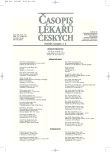Factors Associated with Development of Boy’s Aggressiveness
Faktory asociované s vývojem agresivity chlapců
Východisko.
O silném nárůstu agresivity v populaci není pochyb. Všechna mass-media nás o tomto problému informují. Na základě dat projektu ELSPAC jsme účast ve rvačce považovali za projev agresivity a dle místa ošetření úrazu usuzovali na jeho závažnost. Z údajů podaných v dotazníku (k bohatým informacím o rodině, výchově, zdraví a psychické kondici respondentů) byly hledány vztahy mezi výskytem těchto úrazů i jejich závažností.
Metody a výsledky.
Informace o svých úrazech ze rvaček podalo 894 mužů ze 4,5 tisíc respondentů studie ELSPAC v Brně a ve znojemském okrese, kteří zároveň uvedli, zda byli s úrazem ošetřeni na nemocničním lůžku, ambulantně nebo jen doma. K převážné většině úrazů došlo mezi 16–18 roky.
Závěry.
Rozvrácená rodina, slabost výchovy, defekty scholarity, nízké vzdělání, vyšší nemocnost v anamnéze spolu s vyšší dosavadní úrazovostí respondentů i členů jejich rodin byly zjištěny jako faktory asociované s výskytem úrazů ze rvaček. Závažnost úrazů však byla s těmito faktory asociována méně často než jejich výskyt.
Klíčová slova:
agresivita a rodina, agresivita a úraz, úrazy ze rvaček, agresivita mužů, dětská agresivita, agresivita a zdraví, agresivita a stres, agresivita a vzdělání, agresivita a škola.
Authors:
L. Kukla 1,2; M. Bouchalová 1
Authors‘ workplace:
Výzkumné pracoviště preventivní a sociální pediatrie LF MU, Brno
1; Katedra klinických oborů, ZSF JČU, České Budějovice
2
Published in:
Čas. Lék. čes. 2007; 146: 699-707
Category:
Original Article
Overview
Background.
There is no doubt about the aggressiveness increase in the population. All mass-media keep informing us about this problem. Based on the project ELSPAC data we considered participation in a brawl as an expression of aggressiveness and estimated its gravity depending on the place of treatment. From the information given in the questionnaire (wide variety of information about the respondent’s family, upbringing, health and psychic condition) we searched for relationships between these injuries and their gravity.
Methods and Results.
894 men out of 4,5 thousand ELSPAC study participants in Brno and the Znojmo district gave information about their injuries from brawls and they also stated if they were treated with the injury on the hospital bed, as an outpatient or only at home. The vast majority of the injuries happened between their 16th – 18th year of age.
Conclusions.
Dysfunctional family, ineffective upbringing, scholarity defects, low education, higher morbidity in the personal history together with the higher up-to-date accident rate of the respondent and his family members were assessed as factors associated with brawl injury occurence. The injury gravity was however less often associated with these factors than the injury occurence.
Key words:
aggressiveness and family, aggressiveness and injury, brawl injuries, male aggressiveness, child aggressiveness, aggressiveness and stress, aggressiveness and education, aggressiveness and school.
Labels
Addictology Allergology and clinical immunology Angiology Audiology Clinical biochemistry Dermatology & STDs Paediatric gastroenterology Paediatric surgery Paediatric cardiology Paediatric neurology Paediatric ENT Paediatric psychiatry Paediatric rheumatology Diabetology Pharmacy Vascular surgery Pain management Dental HygienistArticle was published in
Journal of Czech Physicians

- Metamizole vs. Tramadol in Postoperative Analgesia
- Metamizole at a Glance and in Practice – Effective Non-Opioid Analgesic for All Ages
- Advances in the Treatment of Myasthenia Gravis on the Horizon
- Current Insights into the Antispasmodic and Analgesic Effects of Metamizole on the Gastrointestinal Tract
- Spasmolytic Effect of Metamizole
Most read in this issue
- Genotyping of CYP2D6 and CYP2C19
- Problems of the Cervical Defects
- Analysis of Circadian Rhythm Influence to Heart Rate Turbulence in Patients Post Myocardial Infarction with Left Ventricular Dysfunction
- Factors Associated with Development of Boy’s Aggressiveness
